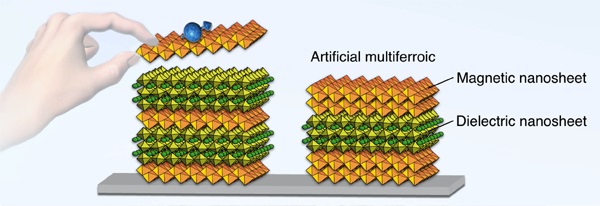New Multiferroic Materials from Building Blocks

Figure. A chemical design strategy for creating artificial multiferroics using oxide nanosheets. Copyright : NIMS
A research group led by principal investigator Minoru Osada and fellow Takayoshi Sasaki, International Center for Materials Nanoarchitectonics (MANA), National Institute for Materials Science (NIMS), successfully developed room temperature multiferroic materials by a layer-by-layer assembly of nanosheet building blocks. Multiferroic materials are expected to play a vital role in the development of next-generation multifunctional electronic devices.
The design of new multiferroics, or materials that display both ferroelectricity and ferromagnetism, is of fundamental importance for new electronic technologies.
However, the co-existence of ferroelectricity and magnetic order at room temperature in single compounds is rare, and heterostructures with such multiferroic properties have only been made with complex techniques (such as pulsed-laser deposition and molecular beam epitaxy).
Seeking to develop room-temperature multiferroics, the research group utilized a new chemical design for artificial multiferroic thin films using two-dimensional oxide nanosheets as building blocks (Figure 1). This approach enables engineering the interlayer coupling between the ferromagnetic and ferroelectric orders, as demonstrated by artificial superlattices composed of ferromagnetic Ti0.8Co0.2O2 nanosheets and dielectric perovskite-structured Ca2Nb3O10 nanosheets.
The (Ti0.8Co0.2O2/Ca2Nb3O10/Ti0.8Co0.2O2) superlattices exhibit the multiferroic effects at room temperature, which can be modulated by tuning the interlayer coupling (i.e., the stacking sequence).
This study opens a pathway to create new artificial materials with tailored multiferroic properties. In addition, the successful development of room temperature multiferroic nanofilms may lead to their application to new memory devices, taking advantage of their multifunctionality and low-voltage operation.
This study was published in the online version of the Journal of the American Chemical Society on June 13, 2016.
Associated links
Journal information
(“Coexistence of Magnetic Order and Ferroelectricity at 2D Nanosheet Interfaces”, Bao-Wen Li, Minoru Osada, Yasuo Ebina, Shigenori Ueda, and Takayoshi Sasaki; J. Am. Chem. Soc., 2016, 138 (24), pp 7621–7625; DOI: 10.1021/jacs.6b02722
Media Contact
More Information:
http://www.researchsea.comAll latest news from the category: Materials Sciences
Materials management deals with the research, development, manufacturing and processing of raw and industrial materials. Key aspects here are biological and medical issues, which play an increasingly important role in this field.
innovations-report offers in-depth articles related to the development and application of materials and the structure and properties of new materials.
Newest articles

First-of-its-kind study uses remote sensing to monitor plastic debris in rivers and lakes
Remote sensing creates a cost-effective solution to monitoring plastic pollution. A first-of-its-kind study from researchers at the University of Minnesota Twin Cities shows how remote sensing can help monitor and…

Laser-based artificial neuron mimics nerve cell functions at lightning speed
With a processing speed a billion times faster than nature, chip-based laser neuron could help advance AI tasks such as pattern recognition and sequence prediction. Researchers have developed a laser-based…

Optimising the processing of plastic waste
Just one look in the yellow bin reveals a colourful jumble of different types of plastic. However, the purer and more uniform plastic waste is, the easier it is to…



